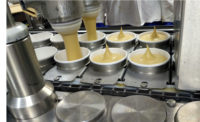
The purchase of new production equipment and the construction of a new frozen-foods warehouse have positioned Perry’s Ice Cream Co. for growth. Its 120,000-square-foot facility in western New York is one of only two large-scale plants in the state.
In 2007 and 2008, a $9 million capital expenditure program (including $1.725 million in grants from the state’s Empire State Development Corp.) included the purchase of automated high-speed production lines, equipment, tanking, 40-degree room and the frozen warehouse.
That investment helped the company land the co-packing account of a Fortune 500 company that exports to the southern hemisphere. Perry’s Ice Cream also co-packs frozen yogurt for Stonyfield Farm, Londonderry, N.H., and manufactures private label ice cream products for Olean Wholesale and Wegmans Food Markets, a regional grocery store chain based in Rochester, N.Y.
As a privately held, medium-size regional dairy processor, Perry’s relies on its informal and networking business relationships with other independents to share best practices. Perry’s membership in the All Star Dairy Association, Lexington, Ky., helps it evaluate and purchase ingredients and packaging to remain competitive.
Perry’s maintains long-term relationships with two Buffalo-based dairy businesses: Upstate Niagara Cooperative, O-At-Ka, its fluid products suppliers, and Sorrento (part of Lactalis American Group), its whey supplier.

It uses the HTST (high temperature, short time) pasteurization/homogenization process. Liquid dairy product, dry ingredients and liquid sugars are blended in 800-gallon tanks. The mix is then sent through the plate frame HTST and homogenizer. There are two separate tanks for frozen yogurt mix.
An additional stage of holding each batch for a period of time replicates how H. Morton Perry, the founder, made his first batch of ice cream on his kitchen stove in the 1930s. Today, the fourth-generation Perry family remains passionate about making ice cream the same way - slow cooked and one batch at a time, which creates a velvety texture and creamy taste.
Ingredients and packaging materials are stored either in the dry warehouse on site or at a local storage facility. The company practices just-in-time inventory, and follows a first-in, first-out policy. A 40-degree room is located within the on-site warehouse for storage of inclusions and ingredients requiring refrigeration. The room is also used to defrost frozen ingredients. “Hot rooms” are also located on-site to temper variegates to the specified usage temperature.
Inventory is color-coded according to its allergen profile (for example, gluten, soy, peanuts and nuts) and stored on racks according to the allergen. The allergen program segregates allergens from other ingredients. All organic ingredients are held on pallets on the top racks, while allergens are stored on pallets on the lower racks.
After pasteurization and homogenization, the mix is pumped to one of 15 pasteurization storage tanks for aging. When the mix is required, it can be pulled through one of four separate lines to any of the 22 numbered flavor vats. There, team members add flavors and inclusions according to the bill of material.
Perry’s schedules run based on the flavors and ingredients to be used in order to minimize changeovers and to reduce the possibility of cross-contamination. For example, Perry’s might first run a batch of chocolate ice cream and then change over to production of chocolate Panda Paws (containing peanut butter), but not the other way around. The plant makes 90 mix bases to create 500 different varieties.
Perry’s Ice Cream is constantly evaluating processes for improvement. This past year, Perry’s reduced the amount of CIP (clean-in-place) chemical use by 8% while maintaining product quality, as well as reducing wastewater treatment costs by approximately $150,000 and production floor waste by 13%.
One of the six lines is for stick novelties. The mix enters multibarrel freezers in a liquid state and exits into the hopper in a soft-serve state. The plant has three molds for stick products - fluted, paddles and twin pops. Molds are eight across. After they are filled, a stick is inserted and the products are dipped in liquid chocolate (if required). The items are wrapped and hand-packed in cartons. A conveyor moves the cartons to the frozen warehouse.
On a bulk-products line, Perry’s fills 2.5-gallon and 3-gallon containers for its foodservice and dip stand (scoop shop) accounts. The mix passes through an in-line metal detector. An operator makes the containers just prior to filling. The operator covers the filled containers with a piece of parchment paper and lid and they are then conveyed to the hardener.
In addition to the bulk sizes, Perry’s makes half-pints, pints, quarts, 48-ounce scrounds (square rounds) and round half-gallons. (Last year it discontinued bricks and slush cups.)
Perry’s has embraced statistical process control (SPC) on its journey to become an efficient ice cream maker. Perry’s measures performance by utilizing Six Sigma tools and OEE metrics. Future investments include voice-picking technology in the warehouse, hand-held computers on the production floor and other emerging technologies.
Perry’s proactively manages plant hygiene and food safety regimens. Perry’s follows CIP and clean-out-of-place (COP) regimens and protocols. Sanitation records are analyzed and stored for reference. Additionally, the company added significant resources devoted to safe, quality food initiatives and has maintained an excellent rating on its SQF certification.
“In food safety, our partners expect us to lead the way,” says Brian Perry, executive vp and vice chairman. “You have to bring your A-game every day.”

Location: Akron, N.Y.
Year opened: 1982, with improvements and expansions in 1984, 1987, 1991, 1997, 2008
Size: 120,000 square feet
Number of employees: 129 in the plant (305 overall)
Products made: Ice cream (including organic), sherbet, sorbet, frozen yogurt, gelato and novelties under the Perry’s brand. The plant co-packs products for other brands and manufactures for private-label accounts. It is Orthodox Union certified.
Total processing capacity: 20 million gallons
Pasteurization: 2,300 gallons per hour; plate frame HTST (high temperature, short time) and Hotwelling (lower temperature, longer time)
Lines: Six lines manufacturing cones, sandwiches, sticks, half-pints, pints, quarts, round half-gallons, 48-ounce scrounds (square-rounds) and bulk tubs
Storage capacity: 88,000 gallons (raw), 75,000 gallons (pasteurized). The frozen warehouse has 3,730 pallet positions.


